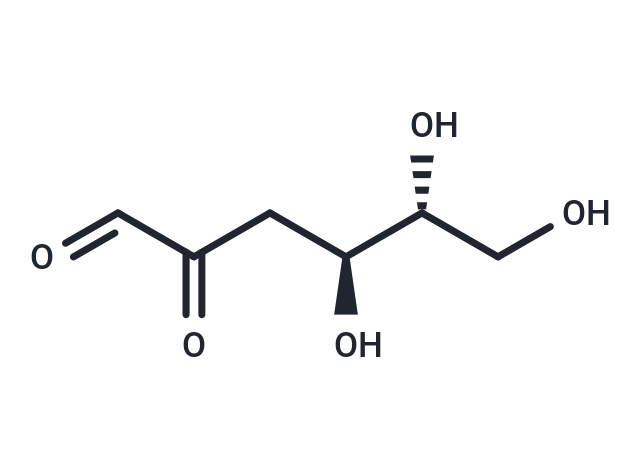- Remove All
 Your shopping cart is currently empty
Your shopping cart is currently empty
Shopping Cart
3-Deoxyglucosone
Catalog No. T19117Cas No. 4084-27-9
Alias 3-Deoxy-D-glucosone, 2-keto-3-Deoxyglucose
3-Deoxyglucosone(3-Deoxy-D-glucosone) is synthesized by the intermediate pathway of the melad and polyol reactions.3-Deoxyglucosone reacts rapidly with protein amino groups to form advanced glycosylated end proteins (AGEs).3-Deoxyglucosone inactivates glutathione peroxidase and synergizes with low glucose to enhance GLP-1 secretion.3-Deoxyglucosone is used as a biomarker for diabetes mellitus.3-Deoxyglucosone has been shown to be an inhibitor of GLP-1 secretion in the presence of low glucose. 3-Deoxyglucosone inactivates glutathione oxidase, synergizes with low glucose to enhance GLP-1 secretion, and can be used as a biologic marker for diabetes.

3-Deoxyglucosone
Catalog No. T19117Alias 3-Deoxy-D-glucosone, 2-keto-3-DeoxyglucoseCas No. 4084-27-9
3-Deoxyglucosone(3-Deoxy-D-glucosone) is synthesized by the intermediate pathway of the melad and polyol reactions.3-Deoxyglucosone reacts rapidly with protein amino groups to form advanced glycosylated end proteins (AGEs).3-Deoxyglucosone inactivates glutathione peroxidase and synergizes with low glucose to enhance GLP-1 secretion.3-Deoxyglucosone is used as a biomarker for diabetes mellitus.3-Deoxyglucosone has been shown to be an inhibitor of GLP-1 secretion in the presence of low glucose. 3-Deoxyglucosone inactivates glutathione oxidase, synergizes with low glucose to enhance GLP-1 secretion, and can be used as a biologic marker for diabetes.
| Pack Size | Price | Availability | Quantity |
|---|---|---|---|
| 1 mg | $188 | In Stock | |
| 5 mg | $478 | In Stock | |
| 50 mg | Preferential | Backorder |
Bulk & Custom
Add to Cart
Questions
View MoreSelect Batch
Purity:95%
Contact us for more batch information
Resource Download
Product Introduction
Bioactivity
Chemical Properties
| Description | 3-Deoxyglucosone(3-Deoxy-D-glucosone) is synthesized by the intermediate pathway of the melad and polyol reactions.3-Deoxyglucosone reacts rapidly with protein amino groups to form advanced glycosylated end proteins (AGEs).3-Deoxyglucosone inactivates glutathione peroxidase and synergizes with low glucose to enhance GLP-1 secretion.3-Deoxyglucosone is used as a biomarker for diabetes mellitus.3-Deoxyglucosone has been shown to be an inhibitor of GLP-1 secretion in the presence of low glucose. 3-Deoxyglucosone inactivates glutathione oxidase, synergizes with low glucose to enhance GLP-1 secretion, and can be used as a biologic marker for diabetes. |
| In vitro | 3-Deoxyglucosone (80 ng/ml-1000 ng/ml; 1 hour; STC-1 cells) induces a 1.23-fold increase in GLP-1 secretion at 300 ng/ml and 1000 ng/ml, while 80 ng/ml shows no effect. At 300 ng/ml, 3DG significantly elevates intracellular Ca2+ levels, as measured by Fluo-3/AM (2.5 μM for 30 mins), but does not affect intracellular cAMP in a cAMP Elisa assay. Additionally, 300 ng/ml 3DG significantly enhances TAS1R2, TAS1R3, and TRPM5 protein expression under both glucose-free and high conditions.[1] |
| In vivo | 3-Deoxyglucosone (20 mg/kg; intragastric administration; single dose) induces a deterioration in glucose tolerance, as evidenced by an increased Area Under the Curve (AUC). Plasma glucagon levels do not show significant differences. The administration of 3-Deoxyglucosone leads to the development of impaired glucose regulation (IGR) accompanied by evident dysfunction of pancreatic islet cells in both Kunming mice and SD rats.[2] 3-deoxyglucosone (5-50 mg/kg; gastric gavage; once daily; 2 weeks; SD rats) exhibits significant increases in the upper small intestine (1.4-fold), lower small intestine (1.4-fold), ileum (1.4-fold), and colon (two-fold) compared to basal levels in their respective control groups. Additionally, there is a noteworthy decrease in the protein expressions of TAS1R2, TAS1R3, and TRPM5 observed in both the duodenum and colon.[3] |
| Cell Research | Cell Line: STC-1 cells. Concentration: 300?ng/ml. Incubation Time: 1 hour [1] |
| Animal Research | Animal Model: SD rats. Dosage: 5, 20 and 50 mg/kg. Administration: oral administration; once daily; 2 weeks [3] |
| Alias | 3-Deoxy-D-glucosone, 2-keto-3-Deoxyglucose |
| Molecular Weight | 162.14 |
| Formula | C6H10O5 |
| Cas No. | 4084-27-9 |
| Smiles | [C@H](CC(C=O)=O)([C@@H](CO)O)O |
| Relative Density. | 1.406g/cm3 |
Storage & Solubility Information
| Storage | store at low temperature | Powder: -20°C for 3 years | In solvent: -80°C for 1 year | Shipping with blue ice. |
Sci Citations
Calculator
In Vivo Formulation Calculator (Clear solution)
Please enter your animal experiment information in the following box and click Calculate to obtain the mother liquor preparation method and in vivo formula preparation method:
Mother liquor preparation method: 2 mg of drug dissolved in 50 μL DMSO (mother liquor concentration of 40 mg/mL), if you need to configure a concentration that exceeds the solubility of the product, please contact us first.
(mother liquor concentration of 40 mg/mL), if you need to configure a concentration that exceeds the solubility of the product, please contact us first.
Preparation method for in vivo formula: Take 50 μL DMSO main solution, add 300 μLPEG300
main solution, add 300 μLPEG300 mix well and clarify, then add 50 more μL Tween 80, mix well and clarify, then add 600 more μLddH2O
mix well and clarify, then add 50 more μL Tween 80, mix well and clarify, then add 600 more μLddH2O mix well and clarify
mix well and clarify
For Reference Only. Please develop an appropriate dissolution method based on your laboratory animals and route of administration.
Dose Conversion
You can also refer to dose conversion for different animals. More Dose Conversion
Tech Support
Please see Inhibitor Handling Instructions for more frequently ask questions. Topics include: how to prepare stock solutions, how to store products, and cautions on cell-based assays & animal experiments, etc
Related Tags: buy 3-Deoxyglucosone | purchase 3-Deoxyglucosone | 3-Deoxyglucosone cost | order 3-Deoxyglucosone | 3-Deoxyglucosone chemical structure | 3-Deoxyglucosone in vivo | 3-Deoxyglucosone in vitro | 3-Deoxyglucosone formula | 3-Deoxyglucosone molecular weight

Copyright © 2015-2025 TargetMol Chemicals Inc. All Rights Reserved.




